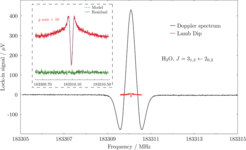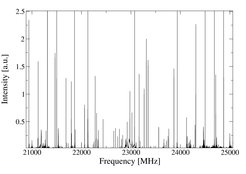CAS laboratories achieve “First Light”

Schematic diagram of the CASAC experiment used to study rotational spectra of light, highly-reactive molecules.
During the early stages of star formation, most of the chemical processes that occur in the gas phase involve small molecules containing relatively light elements (first and second row in the periodic table). The rotational spectra of these molecules can be observed with millimeter/submillimeter telescopes, and provide a useful means to probe the physical conditions and evolution interstellar gas. Because of the large diversity of interstellar conditions, it remains a challenge to prepare and study all the possible molecules and their configurations, both experimentally and observationally.

Recording of a rotational transition of H2O with CASAC. The Doppler spectrum has been recorded at a pressure 15 mTorr, and frequency modulation set at a rate of 15 kHz and a depth of 350 kHz. The much narrower saturation dip has been obtained at a pressure 0.5 mTorr and the frequency modulation set to a rate of 1.5 kHz and a depth of 30 kHz. A model has been fit to this saturation dip, to precisely determine the center frequency at 183310.088(2) MHz.
Two spectrometers being developed by the Center for Astrochemical Studies (CAS) have recently achieved “first light” (the first acquisition of a molecular spectrum): the CASAC (CAS Absorption Cell) spectrometer, and a Chirped-Pulse Fourier Transform Spectrometer (CP-FTS). This marks a new phase of activity since the group's establishment at MPE in 2014. The priorities of the laboratories is the precise determination of spectroscopic properties of astrochmically-related molecules in order to couple this new data with astronomical observations and astrochemical modeling, to enhance the understanding of the processes in which these molecules participate. A cryogenic apparatus for ice studies and an apparatus containing a free-jet supersonic expansion are also under active development.

The CP-FTS coupled to the wave-guide cell. This spectrometer can measure the rotational spectrum of heavier organic species such as prebiotic molecules with their large number of lines.
The CASAC experiment achieved “first light” in February. The experimental setup has since undergone a number of finishing touches, with the final equipment being installed in April. Its primary function is the investigation of light, highly-reactive molecules such as ions and radicals, in a low-pressure, cooled plasma. The instrument operates in the spectral range of 80–1100 GHz (4 mm to 250 μm) using a modular set of Shottky diodes, and thus covers all frequency bands accessed by the world's current state-of-the-art millimeter/submillimeter observing facilities.
A molecular plasma is generated within a 2m-long, 5cm-diameter borosilicate glass tube. The cell is cooled by circulating liquid nitrogen, and is placed within a solenoid magnet. This gives the experimenters the option to confine the plasma to the center of the tube in an axially-aligned magnetic field. Two vacuum pumps provide a high-throughput pumping system, allowing one to maintain a high flow-rate at the pressures needed to generate unstable molecules.

Recording of a 4 GHz scan of the inversion spectrum of an ammonia sample. This spectrum was obtained after an integration of 250,000 pulses over ca. 20 minutes.
A broadband CP-FTS spectrometer has also been developed that initially covers the frequency band from 6 to 26 GHz. At these frequencies, the rotational spectrum of heavier organic species (in particular, prebiotic molecules and their building blocks, containing carbon, nitrogen, and oxygen) can be found. This class of molecules often exhibits complex spectrum with many individual lines due to large-amplitude internal motions. The broad instantaneous spectral bandwidth of the instrument is ideal for simultaneously measuring such a large number of linesand simplifying the line assignment by applying appropriate pulse sequences.
A vacuum-rated, long-pathlength (1.5 m) waveguide has been recently used to record the spectrum of ammonia. The “first light”, its inversion spectrum near 24 GHz, has been obtained early-May. A frequency extension of the instrument is also in progress, to provide access to frequencies in the range of 80–110 GHz. All electronics hardware of the instrument is housed on a mobile rack, so that it may be coupled to various sample chambers that are currently under development.















